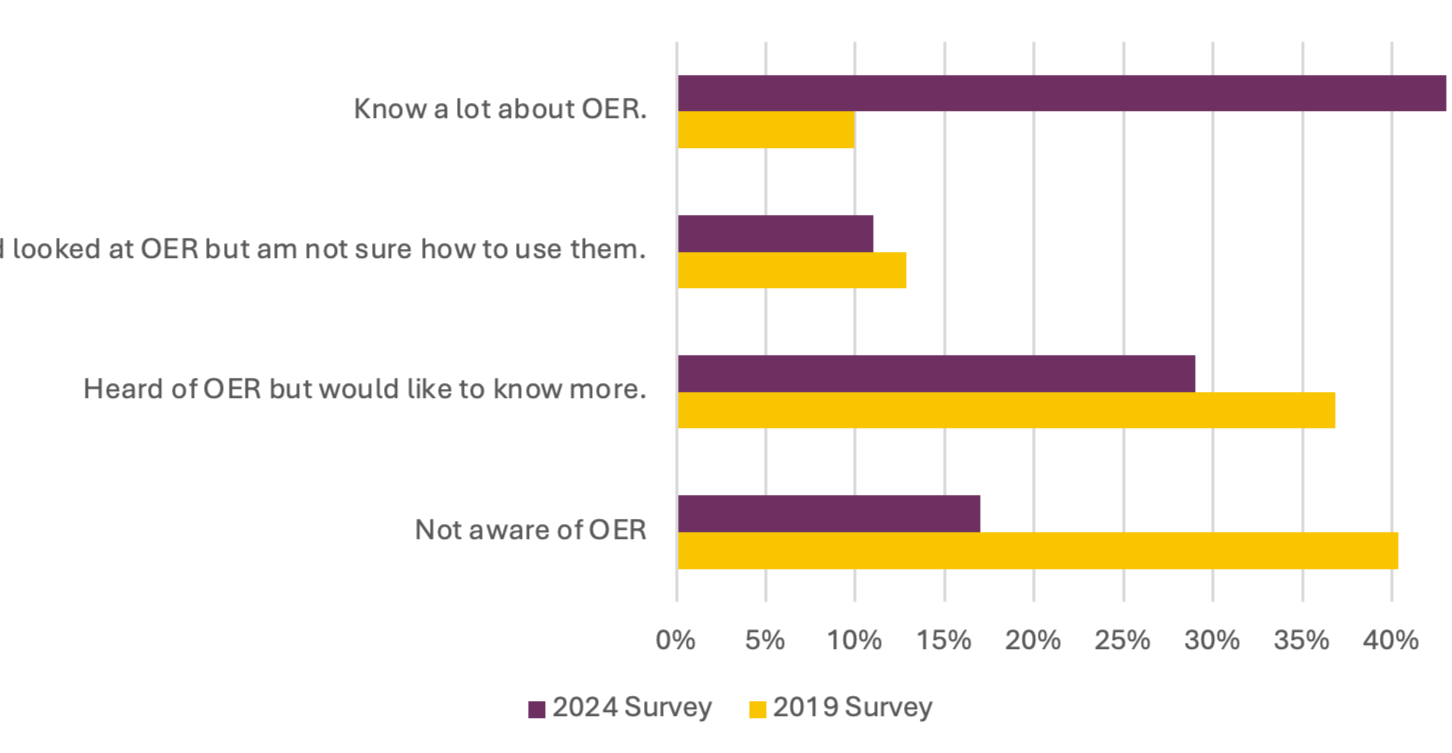2024 WCU Faculty OER Awareness Survey Highlights
To inform our decisions about future OER-related efforts at WCU, the Teach & Learning Center and University Libraries worked together to create and distribute a survey to better understand how WCU faculty use, create, and adapt these materials and now want to share some highlights and some comparisons to a 2019 University Libraries OER survey.
Summary
The 2024 Faculty Survey shows remarkable growth in OER awareness and adoption since 2019. While faculty interest is high (76% interested in using OER), lack of support and resources remains a significant barrier.
The survey captured responses from 89 faculty members. The respondent pool predominantly consisted of tenured faculty (80%), with smaller representations from tenure-track (9%), full-time adjunct (4%), and part-time adjunct (7%) positions.

Growth in OER Usage
+177% Growth
42% now use OER
(up from 15% in 2019)
89% used in undergraduate courses and 76% interested in using OER

Growth in OER Creation
+404% Growth
28% have created/adapted OER
(up from 5% in 2019)

Top Five Motivators
- Student cost savings (79%),
- Quality of OER materials (45%),
- Desire to share knowledge with the community (40%),
- Desire to diversify the curriculum (40%),
- Lack of suitable traditional resources (38%)
OER Awareness and Knowledge Comparison
The survey reveals a significant evolution in faculty's OER knowledge base since 2019:
OER Awareness and Knowledge Comparison Graph (2024 v. 2019)

Types of OER Used
Faculty are utilizing OER across various formats, with textbooks leading at 81%. The high preference for OER textbooks aligns with traditional course material needs while providing cost-effective alternatives for students. The diversity of OER types being used demonstrates faculty's growing comfort with different open resource formats:
- Textbooks: 81%
- Multimedia: 49%
- Course Materials: 43%
- Other (e.g., toolkits, articles): 11%
Course Material Costs
Cost remains a crucial factor in faculty course material decisions, with 93% of faculty considering cost important and 54% rating it as extremely important (up 3% from 2019). However, there is still room for improvement in reducing course material costs with 58% of courses still having materials costing over $50.
- No Cost: 18%
- $1-$50: 24%
- $51-$100: 44%
- $101-$200: 12%
- $201 or greater: 2%
Barriers to Implementation and Creation
Despite growing interest, faculty face several significant challenges in OER adoption:
- Time constraints emerged as the predominant barrier, with 72% citing lack of time as a major concern,
- Inadequate compensation (41%) and copyright/licensing concerns (30%) form secondary barriers,
- Technical challenges and difficulty finding appropriate materials (both 27%) represent significant obstacles,
- Institutional factors such as lack of recognition in scholarship (23%) and insufficient support (21%) also impact adoption.
Resource Usage and Support
Popular Repositories
- Open Textbook Library: 38%
- OER Commons: 30%
- OpenStax: 24%
Desired Support
- Trainings/Workshops: 64%
- Financial Incentives: 64%
- Technical Support: 61%
Implementation and Benefits
OER Key Benefits
- Reduces student financial burden
- Improves material accessibility
- Enables content customization
- Supports educational equity
Recommendations
- Establish dedicated OER office
- Provide faculty release time
- Create centralized repository
- Align with equity initiatives
Conclusion
The 2024 survey results demonstrate significant progress in OER adoption at WCU, with faculty showing both increased awareness and implementation. The high level of interest (76%) combined with willingness to create/adapt materials (64%) suggest strong potential for continued growth. However, addressing key barriers—particularly time constraints and support resources—will be crucial for maintaining this momentum.
The strong consideration of cost (93%) in choosing materials indicates that faculty are increasingly aligned with institutional goals of improving educational accessibility and affordability. With targeted support and resources, WCU would be well-positioned to continue its positive trajectory in OER adoption and creation.
